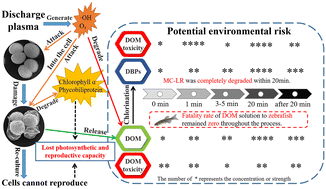Removal of toxic Microcystis aeruginosa using discharge plasma: mechanism and potential environmental risks†
Abstract
Cyanobacterial blooms endanger water safety, and their removal may bring a series of environmental risks. In this study, a typical toxic algae in water, Microcystis aeruginosa (M. aeruginosa), was removed by dielectric barrier discharge plasma, and the mechanism and potential environmental risks were explored. Results showed that the removal efficiency of M. aeruginosa reached 96.2% after 40 min of treatment under optimal conditions. The cell membranes were damaged after 2 min of treatment and more than 95% of chlorophyll and phycobiliprotein were removed after 5 min. Recultivation experiments showed that M. aeruginosa effectively lost its ability to reproduce and photosynthesize within 5 min. Although the plasma can effectively remove M. aeruginosa, the destruction of the algal cell structure during the removal process leads to the release of intracellular substances. This resulted in changes in the dissolved organic matter (DOM) content of the solution, wherein the dissolved organic carbon and dissolved organic nitrogen increased by 5.3 times and 4.7 times after 40 min of treatment, respectively. The increase of DOM resulted in changes in environmental risks. Microcystin-LR was completely removed after 20 min. The total disinfection byproducts and their calculated toxicity reached a maximum at 20 min, followed by a decrease of 19.1% and 19.2% at 40 min, respectively. The relative activity inhibition of DOM on CHO cells increased by only 1.5% from 0 min to 40 min and decreased by 10.3% for chlorinated DOM. These results indicated that the plasma can remove algae and reduce the potential environmental risks caused by the released DOM. Thus, discharge plasma technology is an ideal way to removal M. aeruginosa in water, and may be applied to the practice of controlling cyanobacterial blooms.

- This article is part of the themed collection: Environmental Science: Water Research & Technology Recent Review Articles


 Please wait while we load your content...
Please wait while we load your content...